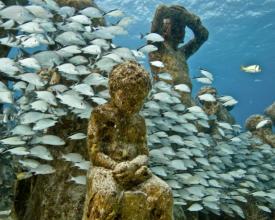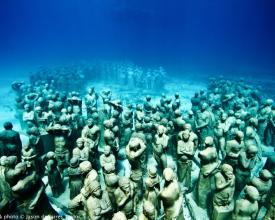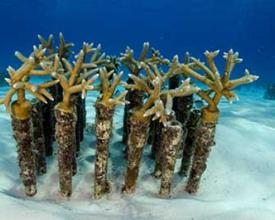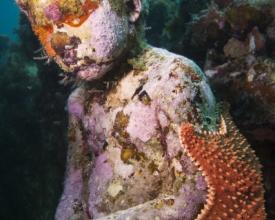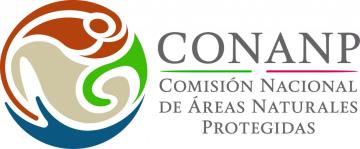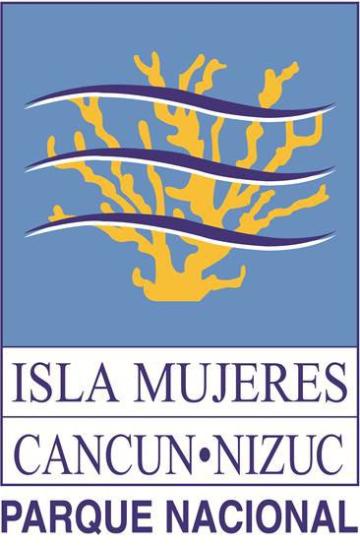
Mitigating human impacts on coral reefs
Full Solution
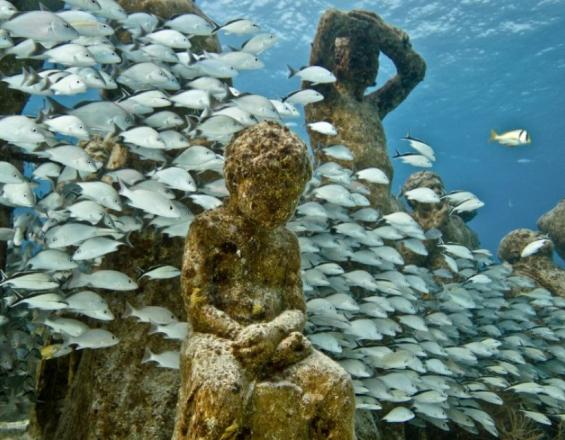
Silent Evolution (25)
Jason deCaires Taylor
In order to alleviate human pressure on the reefs of the national park and allow for sufficient recovery time, an underwater art museum was established. It draws visitors away from the natural reefs while creating new artificial habitats. The evolving interaction of art and sea creatures helps to increase both the ecological awareness of visitors and the overall biomass of the reef system.
Last update: 30 Sep 2020
7072 Views
Context
Challenges addressed
pressure on the natural reefs due to high number of tourists
The National Marine Park is an aquatic touristic attraction with high visitor numbers which places and immense pressure on the natural coral reefs, e.g. critical damage from experiences divers or people kicking or touching corals and reef formations.
Location
Mexico
Caribbean
Process
Summary of the process
= will be added = (available in Spanish)
Building Blocks
Mentoring national park staff
Local practitioners are equipped with technical expertise in project design and leadership skills: individually tailored trainings and mentoring are customised to fellows’ needs and ambitions, while group workshops focus on effective communication strategies, public speaking, negotiation and conflict resolution, advocacy and personal development.
Enabling factors
NA
Lesson learned
NA
Underwater art museum
Life-sized concrete sculptures form an artificial reef structure for marine life to colonise and inhabit. The museum helps to reduce pressure on natural reefs by redirecting visitors to alternative sites. The museum is divided into two galleries: the first is eight meters deep and suitable for both divers and snorkelers and the second is four meters deep and only for snorkelers.
Enabling factors
Cooperation with the tourism sector to redirect tourists from natural reefs to the underwater art musuem. Broad knowledge about reef habitat locations.
Lesson learned
Artificial habitats help to reduce the human impact on natural reef habitats. Faster recovery of natural habitats affected by human impacts. A profound knowledge of the local hydrometeorological conditions.
• Creation of agreements with various stakeholders is important
Restoration of coral reefs
Coral nursery and coral propagation projects are implemented to reduce the time of recruitment and growth and to mitigate anthropogenic and naturally induced impacts. This helps to increase the diversity of coral species and overall coral cover, as well as the variety and abundance of fish and other reef-associated organisms.
Enabling factors
Continous care of the nursery to improve survival. Continuous training of new personell. Resources for the acquisition of equipment for the establishment of the museum. Periodical monitoring of project’s success.
• The British Embassy through DEFRA provided initial funding and then CONABIO has been funding the rehabilitation project and creation of the nursery coral
• Cooperation of the park management with other institutions is necessary to implement the project and to achieve it’s objectives
Lesson learned
Elemination of the sources for the degradation of the reef Habitat. Communication and, if possible, cooperation with specialists and research institutions. Involving the tourims sector into the implementation of rehabilitation activities.
• Communicating the project progress to the local community as well as within the tourism sector
Resources
Impacts
The bio-indicators are improved, for example the coral coverage increased which in turn increased the number and amount of fish species. The strategies implemented to create alternative places to visit in the national park and the rehabilitation of degraded zones show positive results. The combined effect of decreased pressure by tourists and the restoration with nursed corals in damaged zones, decreases the recovery time of affected natural reefs. Taking into perspective the present and future impacts of climate change, the implementation of these strategies will be critical to mitigate its potential effects.
Beneficiaries
tourism industry, tourists, national park authorities
Story
available in Spanish only
Connect with contributors
Other contributors
Jaime Manuel González Cano
Parque Nacional Costa Occidental de Isla Mujeres Punta Cancún y Punta Nizuc (PNCOIMPCPN)
